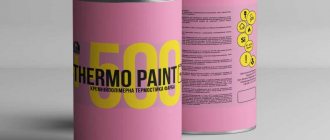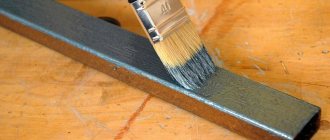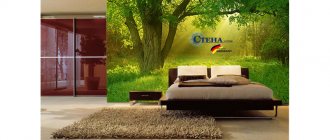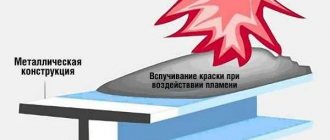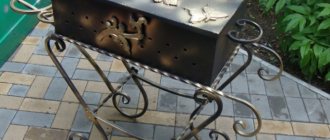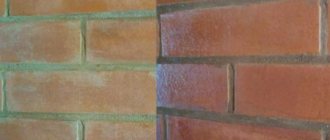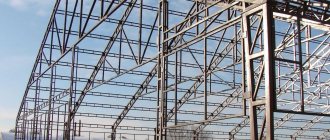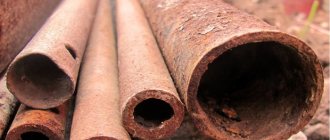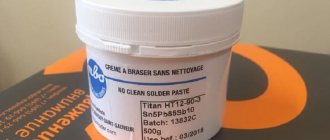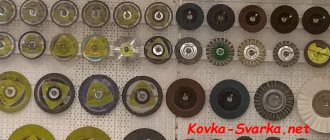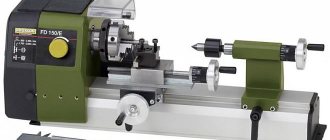Painting metal is not easy. Most of the paints we are used to are not friendly with it - they cannot withstand high temperatures and moisture. But the technology for manufacturing color compositions has undergone great changes. An example of such changes is powder paint on metal. Read to the end and learn how to paint with powder paint, its varieties, as well as some rules and recommendations for application. The mixture is free-flowing and scatters easily, so it is painted using a special technology Source upload.wikimedia.org
Types of powder paints
Powder paint is a material with colored pigment in powder form. It protects the metal surface from moisture and prevents rust. Durability, additional strength and even electrical insulation are its features.
In addition to the pigment, the composition also includes other substances: resins form a film, and catalysts are responsible for hardening. Powder coating is common in construction, automotive and interior design. This way you can achieve a matte or glossy, voluminous or flat surface.
Paint is divided into 2 types:
- Thermoplastic. The decisive factor here is high temperature. Resins are added to the composition: vinyls, nylons or polyester. After heating, they form a hard coating preserving the composition and structure of the original raw material. This powder coating allows the metal object to be reheated and the layers re-formed.
- Thermosetting. Film formation occurs as a result of a chemical reaction. Acrylic, epoxy or polyester resins are used to produce paints.
You can paint objects of any size and even with a complex design Source rzsd62.ru
Thermoactive colors are suitable for products that are used in harsh climatic conditions. Once applied, the powder coating reforms and does not deform when reheated.
The components in the composition are safe. They have a high degree of flowability, which is why they do not stick to objects and skin. The shelf life is unlimited, the color does not fade, and the consistency does not thicken over time. Properties are preserved until the moment of use. No solvent needed.
See also: Catalog of companies that specialize in paints and varnishes and related work
Pros and cons of powder coating
This technology has its advantages:
- during powder painting, no defects (smudges or streaks) are formed;
- no solvents are used, and therefore there will be less emissions of harmful substances into the atmosphere and for the painter to breathe;
- powder coating can achieve a large number of texture effects;
- the hardening time of powder coating is significantly less than its liquid counterparts;
- can create a thicker layer compared to liquid paint; in one application of powder the layer can reach 60-80 microns. Liquid paint must go through this thickness three times;
- Powder-applied coating is less susceptible to chipping and scratching. Also, the color lasts much longer;
- less loss of material when painting the product. So, when using liquid paint, up to 70% of it can be lost. If you take powder, then the losses are only 5% (these losses can be reused in the future);
- No qualifications required to apply powder coating.
Along with such obvious advantages, this technology also has its disadvantages:
- Liquid paint can be mixed with each other to obtain new colors and shades. When mixing the powder, it is impossible to obtain a new color;
- it is very difficult to obtain gloss compared to liquid paints;
- It is very difficult to get a perfectly smooth surface.
Dyeing technology
When powder painting, painting technology is of great importance. The idea is to spray dry particles onto a degreased and cleaned surface. Positively charged paint particles easily stick to a negatively charged metal surface. This creates an even and uniform layer.
Only two spraying methods are used:
- Electrostatic . Electrostatically charged powder is applied to the grounded surface. This is done using a powder coating gun. Kohler acquires an electrical charge due to ionized air. It is located in the corona discharge area and is formed between the electrodes of the charging tip and the surface to be painted.
Electrostatic Painting Source graco.com
A high voltage source is built into the sprayer design. The main disadvantage of this method is the inability to apply paint into small depressions and recesses.
- Tribostatic . This method uses compressed air. As a result of friction with the dielectric, a charge appears. It holds paint molecules on the surface being painted. The dielectric is fluoroplastic - the atomizer is made from this material. This method is used for painting products with complex geometry. It is possible to use multi-jet nozzles, which increase the accuracy and uniformity of paint application.
Painting equipment
To complete the coloring you will need:
- A special chamber for applying the dye, equipped with air suction devices.
- Feeder.
- Pneumatic sprayer, which is connected to the feeder. The result is a gun-like tool with which paint is applied.
- The polymerization chamber in which the procedure necessary to complete the process is performed.
When the sprayer operates, a mixture of air and dye is created. A torch is formed, the particles of the composition receive an electric charge, after which they settle on the workpiece, held by the force of electrical attraction. The shape of the torch depends on the nozzle installed on the gun.
Stages of work
Powder coating technology consists of three stages of work: surface preparation, painting and polymerization.
Surface preparation
It includes: cleaning from contaminants, degreasing, phosphating.
Dirt, rust and oxides are removed from the surface of a metal product. If you skip the cleaning step, the paint will peel off and you will have to redo it. The best cleaning method is shot blasting. Small granules are directed to the surface under pressure or using centrifugal force. Cast iron or steel granules, as well as sand, are used as granules.
Preparing the surface for powder painting
To achieve maximum adhesion, the surface to be painted must be properly cleaned of various contaminants, including traces of oil, wax, and so on. You can clean the surface in the following ways:
- steam based on a solution of chlorinated hydrocarbons. Since the solution does not contain water, it will not form corrosion on the metal;
- water washing is carried out by special machines using a jet of water supplied under high pressure;
- submersible washer. This method uses a series of baths with different solutions to wash and rinse the product;
- At home, it is quite possible to get by by cleaning the parts with special cleaning agents and a brush. If the part is small, you can even wash it in the dishwasher.
Video description
This video shows how to clean rust from metal.
Chemical cleaning or etching is suitable for degreasing the surface before powder coating of metal products. Sulfuric, nitric or phosphoric acids are used as a reagent. Phosphating is similar to priming. When treated with a special composition, a phosphate film is formed, which improves adhesion.
Coloring
For these purposes, a special room is equipped - a chamber - with a forced air suction system. Large-sized products are painted in walk-through type chambers, and small parts are painted in dead-end type chambers. A special gun sprays the color. The step-by-step process looks like this:
- Powder paint is poured into a special hopper and mixed there with air. The proportions are adjusted using valves.
- A mixture of paint and air passes through a spray gun with a high-voltage source, acquiring a positive charge.
- The process of spraying paint onto the product occurs.
- The last step is extraction to remove loose particles. Entering a special bunker, they are again sent through the painting cycle.
Metal paint for external structures: properties
For the first time, paints of this type began to be used in the 60s of the 20th century. Since then, their production technology has been improved and developed. The first advantage of powder paints is the lack of solvent in them. Instead, air plays the role of a dispersed medium. The properties of dry paints differ significantly from their liquid counterparts. It is better in both economic and environmental characteristics.
Film formation parameters are achieved thanks to solid particles and film-forming resins.
Depending on the presence of special coloring pigments, all coloring systems are divided into pigmented and non-pigmented. The latter are used for application as varnished surfaces.
See also: Heat treatment of metal
Video description
This video shows the consequences of underbaking and overbaking paint.
The process of paint polymerization occurs. It takes 15-30 minutes to complete the full cycle. Microparticles of powder paint are melted, forming a film, then hardened and cooled. The time for this stage depends on the size of the part, the type of oven and the type of paint.
The temperature required for the process is kept in the range of 150-200 °C. After which the molten powder fills all small irregularities, this guarantees tight contact between the paint and the surface.
Then the part is cooled. The coating becomes durable, and the product receives protection from adverse environmental influences.
Double layer coating
Basically, powder painting is applied in one layer. But in some cases it will be necessary to apply a second layer. For example, apply varnish to metallic or create a neon shade.
For double layer there are two methods:
- Apply 1 layer and partial polymerization. Then a second layer is applied and final polymerization.
- Each layer is applied and cured separately.
Video description
This video shows the powder coating process
- To spray powder materials, use the minimum required amount of air. When oversaturation occurs, there is an increase in color consumption, increased load on the equipment, disruption of the electrification process, changes in the granules of the powder material, plus, visibility in the spray booth noticeably deteriorates.
- Use air of the best quality, without impurities.
- Carefully homogenize the powder mixture before use.
- Do not mix different colors. Before using a new color, thoroughly clean the equipment.
- Pay great attention to surface preparation before painting.
- Storage conditions for powder paints must be observed to avoid deterioration of the raw materials, which will affect the final result.
- The technological process must be followed in detail at all stages of painting work.
- Monitoring, prevention and maintenance of units is a necessity.
- Correctly configured production cycles guarantee a reduction in the loss of coloring pigment to 2% -5%.
Rules and recommendations will help achieve uniformity and elasticity of the coating, as well as a long service life.
Application in car repair
At the moment, acrylic paints are most often used to mask defects on car wheels. Their practicality lies in the fact that they can be sold in spray cans, which is very convenient for painting. You can get a high-quality result if you carefully spray acrylic paints in a small layer. The attractiveness of these cans is that they can be used to achieve a glossy surface. Buyers are offered a huge selection of colors. A significant disadvantage of acrylic painting materials is that they do not provide chip restoration.
To reliably restore chips, the damaged surface must be primed. Powder paint has good adhesion to the primed coating, that is, it adheres well to it, while efficiently hiding defects. The assortment includes cans that have different concentrations of pigment and allow you to achieve different depths of color. They are able to recreate a glossy surface.
Briefly about the main thing
Powder paint is a modern type of painting materials for metal. The scope of application ranges from painting small household appliances and interior items to metal structures.
There are two main types of powder paints - thermoplastic and thermosetting. The choice of method depends on the tasks at hand. There are also only two types of dyeing technologies - electrostatic and tribostatic. In the first case, a powerful high voltage source is used, in the second it is absent.
Painting is done in 3 stages: first, prepare the surface - clean it of dirt, dust and old layers of paint. Products are painted using an air suction system. The final stage is polymerization. The painted object is sent to the oven to fix the paint, followed by the processes of hardening and cooling.
Disadvantages of powder-based paint
Let us highlight the main five disadvantages that are typical for powder paint:
- Need a new container for each color. You can't use the same thing.
- An explosion is also possible, so you need to handle the can properly.
- It is very difficult to apply a thin layer of paint.
- If the temperature is low, it will be difficult to paint the surface.
- If the structure is non-standard or part of a prefabricated structure, then it will be difficult to use powder paint, since it is sprayed over a large surface area.
Dyeing process and physical features
Powder paints are made up of tiny particles. The particles receive a charge from an external static field; it is opposite to the characteristics of the surface being painted. After charging, the particles simply settle on the surface, and a special layer is formed with a minimum thickness. The deposition chamber captures charged particles. The dust particles themselves have an electric field voltage value that is not enough to connect to the surface of the object. Therefore, the staining is repeated.
Powder paint components that do not stick to the surface can be sprayed onto it again. The main thing is to ensure that the powder is used in full. It is this parameter that makes the technology in demand.
After all the previous stages, the dusty surface is baked, that is, the painted product is transferred to a special chamber. There the polymerization process takes place under the influence of high temperatures. Different types of powder coatings can produce different effects.
On video: technical features and nuances of powder painting.
What is painted with dry paints?
The powder coating method is not suitable for all surfaces. It is used when additional corrosion protection, durability and strength are needed. In some cases, powder paint can provide electrical insulation.
Powder coating is used mainly in industrial production for:
- forged products, aluminum profiles and galvanized metal;
- laboratory and medical equipment;
- furniture;
- household appliances;
- sports equipment.
Bottom line
Powder coating is the most economical, fastest and environmentally friendly way to obtain a reliable protective surface on metal. The service life of the product is significantly increased, and the decorative coating can be varied not only in color, but also in structure.
The difficulties of the technology lie in strict adherence to all stages. This requires a special production line. Problems may arise when:
- painting large items;
- products of complex shape;
- structures made of mixed materials.
Advantages and disadvantages of use
Like any product, powder paints have their pros and cons; the advantages described below can be highlighted:
- Environmental friendliness;
- Low consumption;
- Ability to use sparingly soluble polymers;
- Application of one layer is sufficient;
- Uniformity of composition distribution;
- Ease of processing hard-to-reach places;
- Wear-resistant property;
- Creation of a coating resistant to chemicals;
- Durability.
The disadvantages are:
- Painting requires special equipment;
- Possibility of use only for industrial purposes;
- Tendency to emit dust;
- Powder suspensions are explosive.
Creation of a coating resistant to chemicals.
The powder coloring agent differs in its technical characteristics and gives the metal surface a reliable coating from various negative environmental factors. They are distinguished by their durability, but require painting in special chambers, and you also need a special spray gun to obtain the properties declared by the manufacturers.
